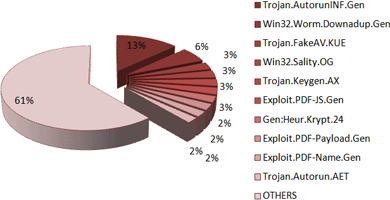
April’s top brings forward two newcomers: a fake AV and a Trojan.Keygen!
April is the third month in a row in which Trojan.AutorunInf.Gen is the top e-threat with 13,21% of the total amount of the global malware. This reveals that removable devices are used on a large scale and their owners are not that aware – still – of the damage waiting for them in the tiny gadgets.
Win32.Worm.Downadup.Gen (Kido or Conficker) is to be found once again shadowing the top Trojan.AutorunInf.Gen with 5,77%. It is the result of a successful exploitation of a Microsoft Windows vulnerability and unfortunately people are hesitant towards updating their operating systems and antivirus solution so as to easily get rid of this obstinate worm.
Ranking third is a newcomer - Trojan.FakeAV.KUE - with a percentage of 2,72 of the total amount of infections. It is not much of a surprise here, since this past week has been mostly about rogue AV. This detection covers JavaScript code that is used to trigger fake alerts on websites connected to the placement of rogue antivirus software. These scripts are hosted on malicious sites and innocent
victim-pages that have been infected.
Win32.Sality.OG is positioned fourth (2,72%) in April’s malware chart, exactly as last month - again as the sole representative of the file infector software. Shielded by a polymorphic packer, the Sality family is extremely difficult to detect and annihilate. In addition to that, the rootkit component of the virus tries to disable various antivirus applications installed on the infected system.
The second new comer of this month’s is Trojan.Keygen.AX – April’s top number five, which intercepts and blocks threats related to cracks, patches and keygens. Generating keys and patches for various applications is a common practice for commercial software on the Internet, P2P platforms, and instant messenger, download sites, social networking environments. It may be popular, but it is also illegal and risky. So, play fair and safe!
Overview of April’s malware distribution chart:

BitDefender’s April 2009 top 10 e-threat list includes:
1. Trojan.AutorunINF.Gen 13,21
2. Win32.Worm.Downadup.Gen 5,77
3. Trojan.FakeAV.KUE 2,72
4. Win32.Sality.OG 2,72
5. Trojan.Keygen.AX 2,66
6. Exploit.PDF-JS.Gen 2,57
7. Gen:Heur.Krypt.24 2,38
8. Exploit.PDF-Payload.Gen 2,34
9. Exploit.PDF-Name.Gen 2,12
10. Trojan.Autorun.AET 2,05
Others 61,40
For more information contact Alina Anton, senior PR and marketing coordinator, EMEA & APAC business unit, BitDefender, +40 212 063 470, [email protected], www.bitdefender.com

© Technews Publishing (Pty) Ltd. | All Rights Reserved.